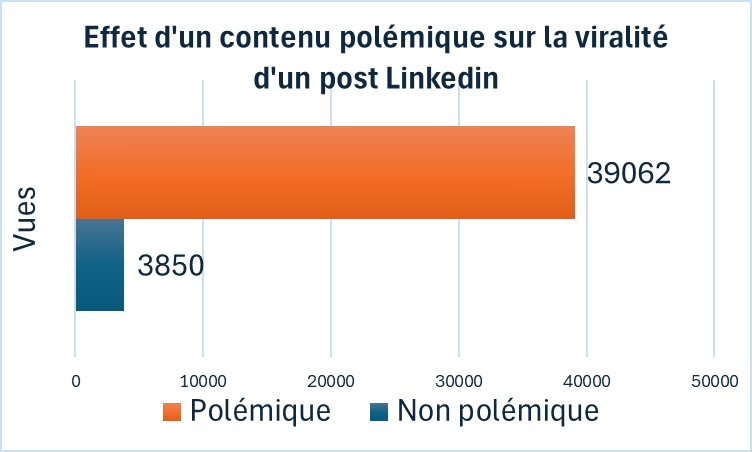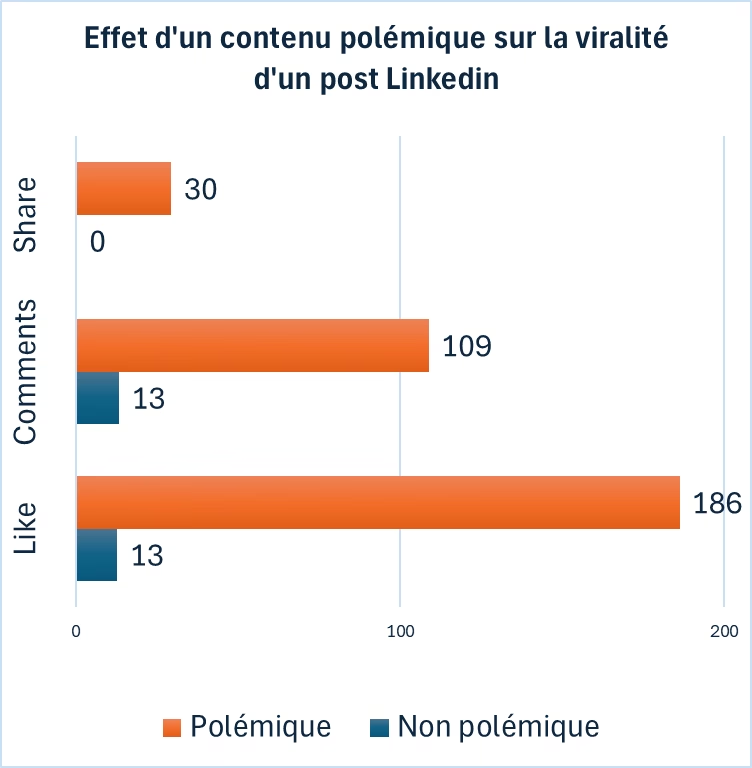Discover in this article the results of exclusive market research on the effect of controversy on the virality of LinkedIn posts.

LinkedIn’s algorithm determines how many people will see a post. For 2 months, I experimented with alternating informative posts with more controversial ones. The results revealed in this market research show that controversy yields 10 times more views on average. But is writing controversial posts a winning strategy on LinkedIn?
Contact IntoTheMinds Market Research Agency
If you have only got 30 seconds
- An experiment on LinkedIn shows that controversial topics generate 10 times more views than consensual ones.
- Likes, comments, and shares are multiplied by 15, 8, and 74, respectively.
- Even after eliminating “outliers,” controversial posts on LinkedIn still generate 4 times more views, likes, and comments and 12 times more shares than consensual posts.ue les posts consensuels.
If you are familiar with LinkedIn, you will know that the visibility of posts scrolling through your “feed” is determined by an algorithm. I’ve already tried to unravel some of its secrets in market research on 5 million LinkedIn posts. However, the algorithm is changing, and it is getting harder and harder to get visibility on LinkedIn. We know the number of Likes, Comments, and Shares in the first few hours after publication determines how much exposure your LinkedIn post will get. So, I wanted to see if it was possible to “hack” LinkedIn’s algorithm by stirring up controversy and inciting debate. Here are the results.
Generating controversy on LinkedIn: what did I do?
To stir up controversy, I wrote posts whose subjects capitalized on people’s frustration: bureaucracy, disrespect, purchasing power, and the election of Donald Trump. As far as possible, I enhanced each post with an image illustrating the subject, most often an image generated by artificial intelligence. I published the posts on a weekday and always between 10:30 and 11:30 a.m. Now for the results.
The results were 10 times more views and 1000 more followers
In the interests of transparency, at the end of this article, you will find all the posts published between December 2024 and January 2025 and their respective metrics.
Two posts, published just a few days apart, were a resounding success:
- Post 1 (left, below): 207,000 views, 1,895 likes, 327 comments and 145 shares
- Post 2 (right, below): 186000 views, 262 likes, 420 comments, 13 shares
These 2 posts alone earned me 1000 followers.
Now for the results. They are indisputable (see graphs below):
Views: controversial posts garnered 10 times more views (39062 views on average vs. 3850 for non-controversial posts)
- Likes: there were 15 times more likes on controversial posts (186 on average vs. 13 for non-controversial posts)
- Comments: controversial posts generated 8 times more comments (109 vs. 13 on average)
- Shares: there were 74 times more shares of controversial posts.
As can be seen from the raw data (see the “Appendix” section of this article), 2 posts were particularly successful, with almost 200,000 views each. Even after removing these 2 “outliers,” the effect of the controversy is still clearly visible. The multiplier effect is still 4 for views, comments, and likes and 12 for shares.
Is it a good idea to create controversy on LinkedIn?
I was astonished by the virulence of the responses:
- Some people pointed out the importance of procedures and standards when I explained that Notre Dame had been rebuilt in 5 years thanks to eliminating bureaucracy.
- My post on jobseekers who no longer call to conduct a test triggered a torrent of sometimes highly emotional comments.
Reading them reminded me of the misadventure of a German boss who complained on LinkedIn that one of his employees spent half her day at the hairdresser. Many Internet users branded him a toxic boss who pleaded for absolute employee confidence.
Although these posts have helped me increase my followers, I doubt their profiles align with what I seek. In my opinion, free “buzz” on subjects far removed from your field of expertise won’t bring you anything. This is also the opinion of my friend Bruno Fridlansky, a well-known French LinkedIn expert (see box below).

“The game of creating controversy on LinkedIn to get buzz can create a disconnect between the professional image perceived online and the reality of the real world. This cognitive dissonance undermines the coherence needed to establish lasting professional relationships.
This (constant) pursuit of buzz through provocation can even backfire by diverting attention away from one’s real expertise. The result is a loss of professional credibility. LinkedIn should remain a working tool focused on developing professional relationships. That is a bit of a polemical position?”
Appendix: List of posts and detailed results
Below is a list of all the posts published during the test period.
| Subjet | Controversial | View | Like | Comments | Share |
|---|---|---|---|---|---|
| Cold emailing | no | 1261 | 2 | 6 | |
| SEO | no | 1290 | 2 | 3 | |
| Packaging | yes | 13603 | 41 | 27 | |
| Bureaucracy | yes | 207397 | 1895 | 329 | 145 |
| Bureaucracy | yes | 186642 | 263 | 420 | 13 |
| Bureaucracy | yes | 44458 | 255 | 89 | 13 |
| Personal hygiene | no | 19753 | 54 | 43 | |
| The year 2000 bug | yes | 5156 | 28 | 8 | |
| DPE / PEB | yes | 5119 | 32 | 16 | 2 |
| Analyse Linkedin | no | 9391 | 43 | 29 | |
| Drone delivery | yes | 2301 | 19 | 22 | |
| Marketing strategy | no | 1351 | 5 | 5 | |
| Vuitton worksite | yes | 1776 | 10 | 4 | |
| CES Las Vegas | no | 1869 | 7 | 5 | 1 |
| Disrespectful prospect | yes | 13906 | 48 | 23 | |
| Website | no | 3262 | 3 | 25 | |
| Public tender | yes | 3620 | 16 | 10 | |
| Critair'3 | yes | 1093 | 5 | ||
| HR study | no | 660 | 7 | 9 | |
| Purchasing power | yes | 1656 | 10 | 6 | |
| Intellectual property | yes | 2256 | 8 | 4 | |
| Bureaucracy | yes | 4893 | 23 | 27 | |
| Donald Trump | yes | 7726 | 23 | 49 | |
| AI & marketing | no | 1059 | 7 | 4 | 1 |
| Marketing trends | no | 196 | 3 | ||
| Job interview | yes | 86586 | 127 | 495 | 4 |








![Illustration of our post "LinkedIn remains under-used by marketing managers [Research]"](/blog/app/uploads/linkedin-logo-120x90.jpg)

